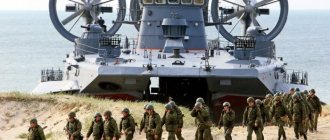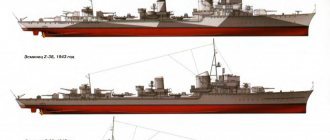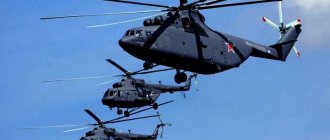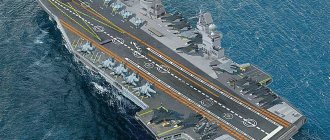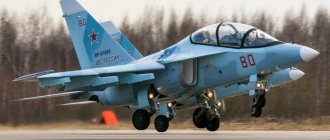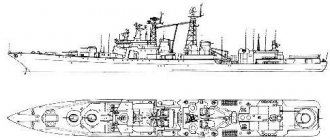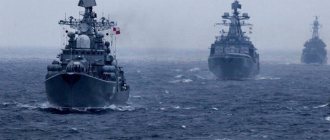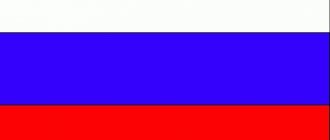Many elements of the Marine Corps uniform approved in the modern Russian army migrated from the times of the USSR, but even in those distant times, not everything was so simple. Over the entire period of its existence, the Marine Corps troops dressed in different clothes, so it is convenient to follow the transformation of uniforms in parallel with the history of the troops.
As a separate and independent branch of the military, Marine Corps was created according to the order of the commander of the Navy in 1940. Moreover, the reorganization initially took place in the rifle brigade of the Baltic Fleet.
As you know, 1941 was marked by aggression from Germany. The experience of the first battles showed that a single brigade was clearly not enough. The formation of the remaining brigades had to be carried out under difficult wartime conditions. Marine units, the analysis showed, performed key strategic actions in many significant battles.
The creation of brigades began in Leningrad and Kronstadt. There, regiments were formed from coast guard personnel, as well as warships. There were four of them in the Baltic Fleet. The total number of contingents in all fleets was more than 120,000 people, these are brigades of the Black Sea, Baltic and Northern Fleet. Also during the Second World War, a marine corps unit based in the Pacific Fleet was formed.
Marine clothing
Initially, there was no strict regulation in terms of soldiers' clothing. The fact that the new type of troops was grouped from sailors and ground troops was also reflected in the external attire. Thus, the first Marines wore a free uniform with elements of a naval or land uniform. Often there was a vest a cap was used as .
For the first time in 1944, such a concept as a uniform Marine Corps uniform appeared. It was from this period that military clothing was divided into dress and field clothing, and it should also be emphasized that there was a third type - casual. The officer's uniform and the appearance of a private were different from each other.
- For officer ranks, the field cap consisted of a protective (green, khaki ) cap . In winter it was replaced by a gray hat with earflaps.
- The next element is a double-breasted cloth overcoat, also gray.
- The jacket was considered all-season and had a green tint ( khaki ). trousers are also the same color .
- The shoes for all representatives of the Marine Corps were yuft boots .
For military personnel up to and including the rank of sergeant, they were required to wear a peakless cap, which was replaced by a hat with earflaps the winter The gray cloth overcoat was practically no different from the officer's. A vest was worn under a khaki shirt . The list of clothes was completed with trousers and yuft boots . An insignia also appeared; it was presented in the form of an anchor and was placed on the left sleeve.
In August 1945, certain units of the MP took part in the Manchurian operation. The fully equipped paratrooper was dressed in a Red Army . Belonging to a particular branch of the military was determined by the vest and cap. The uniform and equipment included a waist belt with an army badge, a machine gun belt, a DP machine gun and a holster with a revolver.
Baltic Fleet
The composition of the marine corps of the Baltic Fleet is represented by the following formations:
- 336th Separate Guards Bialystok Brigade of the Orders of Alexander Nevsky and Suvorov. He is stationed in military unit No. 06017 in Baltiysk.
- 877th separate battalion in the city of Sovetsk.
- 879th separate air assault battalion in Baltiysk.
- 884th separate marine battalion (Baltiysk).
- 1612th separate howitzer-self-propelled artillery division. The formation is based in the village of Mechnikovo.
- 1618th separate anti-aircraft missile artillery division in the village of Pereyaslavskoye.
- The battalion responsible for material support.
- Reconnaissance and landing company.
- Battery of guided anti-tank missiles (ATGM).
- A company of signalmen.
- Rifle company of snipers.
- Flamethrower company.
- Airborne engineering.
The marine corps of the Baltic Fleet is also equipped with a commandant platoon, medical assistance and technical service companies.
Next global change
A special legislative document dating back to 1963 approved a new procedure regulating the list of elements of uniform for the MP and, accordingly, the amphibious assault. By the same decree, the old uniform was abolished. The combat uniform, like the field version, was considered simplified. For frequent or even daily use, officers were required to wear clothes made of wool blend material, and sergeants and sailors were required to wear some elements made of cotton fabric.
The beret , like a headdress , was the same black color, but the material was different. Officers wore a woolen beret , sergeants were entitled to both woolen and brushed ones, and sailors only wore brushed cotton ones. Externally, the woolen one had a difference in the form of a leatherette side. The brushed beret is equipped with a fabric side. The beret differed from the modern one in that instead of a red pennant, a star was attached to it. A vest was worn under a black jacket .
The patch on the left, made on the sleeve, is still considered one of the symbols of the MP. It was chevron , on which a yellow anchor was inscribed in a burgundy-colored circle. If we start talking about shoes, then everything is clear here: for officers and ordinary ordinary sailors, the only option was yuft boots with a shortened top. Only officer boots had leather soles, while the rest had rubber soles.
Purpose of workwear
The regulations on its wearing establish that special distinctive clothing is required to be worn by:
- military personnel who are currently serving,
- all employees sent to the reserve during training camps,
- all generals, admirals and officers transferred to the reserve or resigned, when the right to wear the uniform remains with the individual.
The new uniform of the Russian Navy military personnel looks like in the photo:
The overalls are designed to protect a person when entering cold water. Pants and a skirt for women allow you to create an air gap and avoid rapid hypothermia. Also, their unique cut helps with a quick movement to get rid of clothes, get rid of excess ballast in water or in case of fire.
The shirt allows you not to freeze from the wind and not to sweat in the heat. Outerwear protects from strong gusty winds without hindering movement. Hats prevent sunstroke by covering your head from the scorching sun. The thick soles on the shoes prevent your feet from slipping on a wet surface, and the one-piece shoes without laces do not allow moisture and wind to pass through.
Additions from 1964
Since August 1964, some changes have been made to the infantryman's dress uniform. Black cloth trousers were worn at graduation, and chrome boots . For just one year, changes affected the appearance of the shoulder straps . The red edgings provided for officers were abolished already in 1965.
For MP troops performing missions in areas with high-temperature (hot, humid) climates, a special version of the uniform is provided. It is represented by a beige Panama hat and a short-sleeve shirt. The material for shoulder straps is the same as for a shirt . Trousers were worn for graduation, and sandals were used as shoes. Soldiers and sailors were entitled to a blue jacket and shorts . The specificity of the style was that the sleeve of the jacket was short, like the sleeve of the shirt.
Since 1967, red pennant has been placed on the beret. It is still considered one of the symbols of the Marine Corps. For soldiers who took part in the Victory Parade in Moscow, the pennant was located on both sides. When the box passed through Red Square, the mausoleum with stands was on the right, so the pennant was duplicated.
It should be noted here that such orders concerned the dress uniform and were agreed upon personally with the Minister of Defense. Such an innovation was not documented. The same applies to the “ guys ” collar, which is also used to decorate the modern demobilization uniform.
In 1969, the cockade on the beret changed. It is now oval shaped. The picture is presented with a golden border, inside of which there is a red star on a black background. This sign was assigned only to the cockade for berets. There were no analogues in other branches of the military.
Clothes , defined as everyday clothes and intended for marches or field trips, did not differ in appearance among all ranks, but the material was different. Officers were entitled to a shirt and trousers made of polystyrene, and sailors from cotton wool. Sailors wore the PSh only during routine checks of the highest level. Armrests can be seen on the shirts, and knee pads on the trousers.
At the November 1972 parade, MP troops were represented by soldiers in black suits with white aiguillettes. Now every demobilization officer considers it his duty to decorate his uniform with this element, although it never became statutory.
The history of the appearance of such a dress uniform
The first time the Navy dress uniform arose during the reign of the great Peter the Great. Its appearance is associated with the emergence of the Russian Navy itself. The date of this event is well known - the thirtieth of October.
First, uniforms were introduced. It was intended to be worn by sailors and lower ranks. This item of clothing looked like this:
- Jacket.
- Cropped trousers. The color of the pants and jacket was green. And these wardrobe items were sewn from coarse woolen fabric.
- The set also included stockings.
- Broad-brim.
- Shoes made of genuine leather.
This Navy uniform was copied from the Dutch naval uniform.
Innovations in 1984
The highest legislative body of the USSR, with its document of 1984, introduced a new field uniform format, specifically designed for military personnel serving in the MP. It was developed in both winter and summer versions. Camouflage material is used for the first time. The traditional protective form is also not abandoned, and both of these materials are used as a vole. Practice has shown that they did not equip the landing troops with khaki uniforms, so camouflage secretly began to be considered the calling card of a Marine. It was worn strictly as a vest, with chevron . The cockade on caps and hats is made in green.
Since 1988, the famous oval cockade that adorned the beret has been replaced by a star in a gilded wreath. From this point on, certain elements could be permitted by internal order from the unit commander. Among them are a black cap with a white cover, a black beret or black jacket , cap , an overcoat in summer (in case of cold weather), and a raincoat. a knife when performing combat missions . It is included in the ammunition of modern equipment.
This is where the history of the USSR Marine uniform ends, along with the era. The Russian army in many ways became the successor to the USSR army. Only the symbolism has changed. In all troops , the cockade on the winter hat was replaced by an oval with a tricolor. It is known that Valentin Yudashkin became a fashion designer for law enforcement agencies. The question of the beauty and practicality of the form must be digested for years. But one thing can be said with confidence - the Marine Corps uniform remains one of the most beautiful in the Russian Armed Forces.
